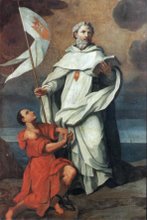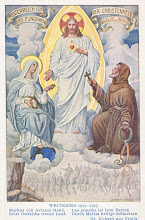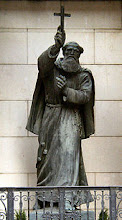Am Sonntag, den 1. März, nach dem heiligen Amt um 11 Uhr, fand die Segnung des neuen Altarbildes in der frisch renovierten Agnes Kapelle in der Wiener Karlskirche durch S.E. Bischof
Frantisek Vaclav LOBKOWICZ OPraem statt. Das Bild zeigt die
hl. Agnes von Böhmen, den hl. Serapion, sowie einen Kreuzherren, mit dem Heiland in einer Pietaszene. Das etwa 2 mal 3 Meter große imposante Gemälde stammt von Clemens Maria Fuchs (
www.clemensmariafuchs.com). Die heilige Agnes v. Böhmen hatte den Orden der Kreuzherren mit dem Roten Stern im Jahre 1233 in Prag gegründet. Seit 1738 obliegt die Seelsorge in der Wiener Karlskirche diesem Orden.
Für uns Mercedarier ist dies ein Ereignis von besonderer Bedeutung. Nicht nur genießen wir seit vielen Jahren die Gastfreundschaft der Kreuzherren und halten unsere allmonatlichen Gebetstreffen in der Agneskapelle der Karlskirche ab, sondern ist auch die Darstellung des
hl. Serapion, des ersten Märtyrers unseres Ordens, nördlich der Alpen eine absolute Rarität. Der hl. Serapion lebte Anfang des 13. Jahrhunderts für geraume Zeit in Wien, zur selben Zeit als sich auch die hl. Agnes in Wien aufhielt. Später ging der junge Serapion nach Spanien, wo er den
hl. Petrus Nolascus kennenlernte und in dessen damals noch jungen Mercedarierorden eintrat. Im Jahre 1240 erlitt der hl. Serapion den Märtyrertod, als er sich in Nordafrika im Austausch für christliche Sklaven in die Gefangenschaft der muslimischen Mauren begab.
Die Angehörigen der Wiener Kommende der Ritter des Mercedarierordens (Compagnia di Santa Maria della Mercede) nahmen auf Einladung des Kreuzherrenordens im Ordensgewand an der Bildsegnung teil.
Hier die Bildbeschreibung durch den Meister selbst:
Saint Agnes of Bohemia. Altarpiece by Clemens
Maria Fuchs:
Size: 3 m X 2 m
Technique: oil on panel
I completed this painting after five weeks of work, a
week and a half ago. I painted this altarpiece for the Chapel of Saint Agnes in
the magnificent church of St. Charles Borromeo in Vienna. It was inaugurated
yesterday by his Excellency Msgr. Frantisek Václav Lobkowicz, Bishop of
Ostrau-Troppau. The painting was commissioned by Father Martin, provincial of
the Order of the Holy Cross with the Red Star for the province of Vienna St.
Karl Borromeus.
Saint Agnes is depicted on top placing, one of her
hands on the head of Christ and the other on His arm. She's wearing the habit
of the Order of St. Clare of Assisi.
On the right you see the figure of Saint Serapion, a
member of the Mercedarian Order and martyr, carrying Christ. Christ is depicted
in the center of the group in a type of Pietá pose. While a priest of the
Order of the Cross with the Red Star is shown kneeling and carrying Christ by His
legs.
The composition is similar to a Pietá. Through Christ’s
life and death, He set the example for us to follow. Through Christ's life and
death and His sacrifice, Saints such as St. Agnes and St. Serapion were
inspired to follow Him.
St. Agnes, through her life of penance, prayer and her
undying service to the poor, sick and dying, she sacrificed her life at the
Bohemian court of luxury and power for a life of poverty, prayer, penance and
serving the poor and the sick.
St. Serapion follows Christ through his heroic acts of
freeing slaves from captivity in Muslim countries and his brutal martyrdom in
Algiers.
Both Saints took up their crosses according to their calling
and followed Christ to sainthood.
The kneeling figure represents the Order of the Holy
Cross with the Red Star, the foundation of St. Agnes and her spiritual and
physical remnants.
All the three figures surrounding the Body of Christ,
place their hearts on a particular part of Christ's body. Since in eastern
Christian symbolism, the heart is the see of the soul. Christ, through His life
and death, touched these saints' hearts and souls.
The chapel of St. Agnes is also devoted to the regular
adoration of the Blessed Sacrament. That's why the Body of Christ is at the
centre of the composition – a little like a monstrance.
For me it was important that the figures have deep
spiritual union, whether by physical sense of touch or a spiritual sense that I
wanted to convey through the intensity in the eyes.
This painting should portrait the charisma of those
saints, but should also inspire the viewer to prayer.
This painting is dedicated to St. Agnes, St. Serapion,
and to the work and sacrifice they offered but also to all the people who were
supportive in a spiritual, moral and physical manner. I want to thank the
parish priest of Karlskirche, Father Martin, and the Mercedarierkommende
Wien Marco d'Aviano for giving me the opportunity to create this painting
for one of the most beautiful churches in the world. I want to thank all my
family and friends, who supported me morally and spiritually, and the great
models that posed for the figures of this painting.
I am deeply honored to have served the Church in this
way and I hope that soon I'll have another opportunity to do so.
This painting is an act of my faith and an offering to
God and His Church!
At the centre of the theme of this altar piece is
Faith, Hope and Love.
Many Thanks to God and to all my friends and family
for your support and inspiration!
God bless you!










